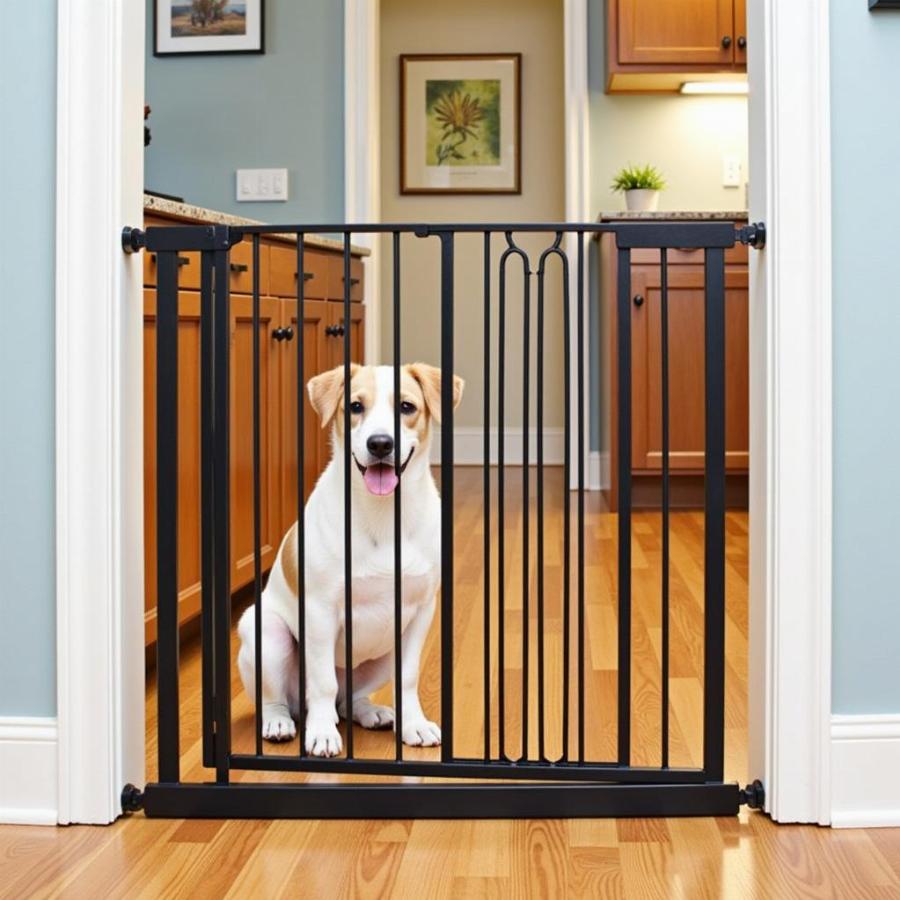Dog door gates are essential tools for pet owners who want to confine their furry friends to specific areas of the house while ensuring their safety and well-being. Whether you need to keep your mischievous puppy out of trouble, create a safe space for your senior dog, or simply manage the flow of your multi-pet household, dog door gates provide a practical and effective solution.
Choosing the right dog door gate can be overwhelming with so many options available. This comprehensive guide will walk you through everything you need to know about dog door gates, from choosing the right type to installation and safety tips.
Types of Dog Door Gates
The ideal dog door gate depends on your needs and the layout of your home. Here are the most common types:
1. Free-Standing Gates
As the name suggests, free-standing gates are independent structures that require no installation. They are ideal for doorways and hallways and offer excellent portability. Some free-standing gates come with adjustable widths to fit different openings.
2. Pressure-Mounted Gates
 Pressure-Mounted Dog Gate
Pressure-Mounted Dog Gate
Pressure-mounted gates are secured by pressure applied to the walls or door frame. They are relatively easy to install and remove, making them a popular choice for renters. However, they may not be suitable for homes with young children who could easily dislodge them.
3. Hardware-Mounted Gates
Hardware-mounted gates offer the most secure option as they are permanently installed using screws. They are ideal for areas where you need extra security, such as staircases or rooms with delicate furniture.
Factors to Consider When Choosing a Dog Door Gate
Before purchasing a dog door gate, consider the following factors:
- Size and Breed of Your Dog: Measure your dog’s height and width to ensure you choose a gate tall and sturdy enough to contain them.
- Location: Determine where you will use the gate and measure the opening’s width.
- Material and Durability: Choose a gate made from durable materials like metal, wood, or heavy-duty plastic that can withstand your dog’s chewing or scratching.
- Ease of Use: Consider how easy the gate is to open and close, especially if you frequently pass through the area.
- Style and Design: Select a gate that complements your home’s decor.
Installation and Safety Tips
- Follow Manufacturer Instructions: Always follow the manufacturer’s installation instructions carefully.
- Test the Gate Thoroughly: Once installed, test the gate thoroughly to ensure it is secure and functioning correctly.
- Supervise Your Dog: Never leave your dog unattended with a new gate until they are familiar with it.
- Regular Maintenance: Inspect the gate regularly for any signs of damage or wear and tear.
Benefits of Using Dog Door Gates
- Safety: Dog door gates prevent access to hazardous areas, such as kitchens with hot stoves or staircases.
- Training: They can help with house training by limiting your puppy’s access to certain areas.
- Peace of Mind: Dog door gates offer peace of mind, knowing your furry friend is safe and secure in a designated area.
“Dog door gates are invaluable for managing a multi-dog household,” says renowned veterinarian Dr. Emily Parker. “They can prevent resource guarding and create a sense of security for dogs who need their own space.”
Dog Door Gates: A Worthy Investment
Investing in a high-quality dog door gate is crucial for any responsible pet owner. They provide a safe and controlled environment for your furry friend, giving you peace of mind. With various options available, you can find the perfect gate to meet your dog’s needs and complement your home’s style.
FAQs About Dog Door Gates
Q: Can I use a baby gate for my dog?
A: While some baby gates might seem suitable, it’s best to choose dog-specific gates designed to withstand a dog’s strength and chewing habits.
Q: Are dog door gates difficult to install?
A: Installation varies depending on the type of gate. Pressure-mounted gates are generally easy to install, while hardware-mounted gates require more effort.
Q: Can I leave my dog alone with a door gate?
A: It’s best to supervise your dog, especially when introducing them to a new gate. Once they are familiar with it and you are confident in its security, you can gradually increase the time they spend alone with it.
Looking for More Ways to Keep Your Dog Safe and Happy?
Check out these related articles:
About Beaut Dogs
Beaut Dogs is your one-stop resource for all things dog-related. We provide reliable and insightful information to help you understand and care for your canine companion better. From breed guides to training tips and product recommendations, we’re here to guide you on your journey as a dog owner.
Need assistance? Contact us at [email protected] for expert advice and tailored solutions for all your dog-related queries.